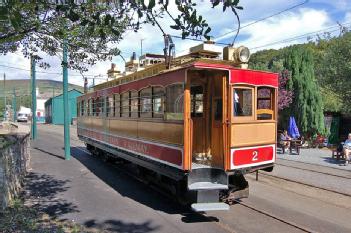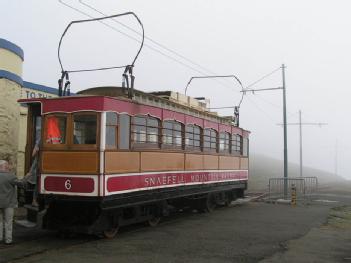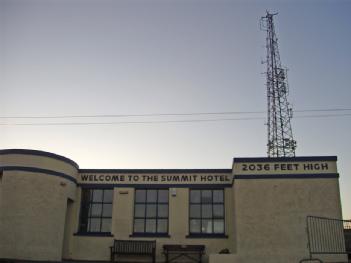
Snaefell Mountain Railway |
IM4 7NH Laxey, Great Britain (UK) (Isle of Man) |
|
| Address |
|
| Floor area | unfortunately not known yet |
Museum typ
Mountain Railways & Cableways
|
Opening times
|
End of March - October up to 22 trips per day, see timtable PDF at www. There is no winter service: the overhead wires on the exposed upper part of the route are taken down to avoid damage from icing. |
||||
|
Status from 10/2016
|
www.gov.im/categories/travel-traffic-and-motoring/bus-and-rail/tickets-fares | ||||
| Contact |
|
||||
| Homepage | www.gov.im/categories/travel-traffic-and-motoring/bus-and-rail/heritage-railways/snaefell-mountain-railway | ||||
Our page for Snaefell Mountain Railway in Laxey, Great Britain (UK), is not yet administrated by a Radiomuseum.org member. Please write to us about your experience with this museum, for corrections of our data or sending photos by using the Contact Form to the Museum Finder.
| Location / Directions |
The Snaefell Mountain Railway (Manx: Raad-Yiarn Sniaull) is an electric mountain railway on the Isle of Man in Europe. It joins the village of Laxey with the summit of Snaefell, at 2,034 feet (620 m) above sea level the highest point on the island. It connects with the Manx Electric Railway (MER) in Laxey. |
| Description | The line is 5 miles (8.0 km) long, built to 3 ft 6 in (1,067 mm) gauge and uses a Fell Incline Railway System centre rail for braking on the steep gradients. It is electrified using overhead wires at 550 volts direct current, with bow collectors.
OperationServices operate at regular intervals between April and September, taking 30 minutes for a one-way journey. There is no winter service: the overhead wires on the exposed upper part of the route are dismantled to avoid damage from icing. All passenger traffic is carried in six wooden-bodied electric railcars, built in 1895 and numbered 1 to 6. Car 5 was burned out in an accident in 1970 and its body is a replacement built in 1971 to a similar design. The cars were re-equipped in the late 1970s with new bogies to a design based on the original, using motors and traction equipment from withdrawn Aachen trams.Because of the different gauge and the centre rail, vehicles cannot inter-run between the railway and the 3 ft gauge MER. Railway vehicles are occasionally worked to the MER workshops at Douglas by swapping their bogies, and to aid this there is a dual gauge siding in Laxey Rolling stockThe railway operates with five of the original six identical tramcars, all of which were built 1895 by George F. Milnes & Co., and delivered in time for the line's opening that year.Of note is Car No. 5 which was severely damaged by a fire on 16 August 1970 and subsequently re-built locally, re-entering service in 1971. It was distinguished by having modern aluminium framed "bus" type windows but these were removed and wooden sliding ones re-fitted during a subsequent re-build in 2003, at which time the tram became the first to carry the railway's name in Manx along its side. The current livery has been standard for over a century, save for a period upon nationalisation in 1957 when certain cars carried an unpopular green and white scheme. The original livery used until 1899 was a cream and Prussian blue scheme featuring "tramway" wording (rather than "railway" which has since been favoured). With the extensive rebuild of Car No. 1 commencing in 2011, this car has been chosen to revert to the original colour scheme complete with original wording, the first time a markedly different livery has been carried by any of the cars since the abolition of the short-lived nationalisation (green and white) colour scheme in 1962. Until the addition of rheostatic braking equipment on car roofs in 1970 knifeboard adverts were carried on the roof tops. Car No. 3 was totally destroyed in an incident on 30 March 2016, when it ran away from Summit station and subsequently derailed. The Hopkinson bow-collectors used on these cars are unique in the world. The cars take about half an hour for the journey from Laxey, but with the ex-Aachen motors as fitted in the 1970s, they could, if necessary, do it in under ten minutes. Fell mountain railway systemDiscription see Fell Locomotive Museum.The Snaefell Mountain Railway still uses the Fell system for (emergency) braking, but not for traction. |
Radiomuseum.org presents here one of the many museum pages. We try to bring data for your direct information about all that is relevant. In the list (link above right) you find the complete listing of museums related to "Radio & Co." we have information of. Please help us to be complete and up to date by using the contact form above.
[dsp_museum_detail.cfm]
| Data Compliance | More Information |
 gov.im
gov.im 


